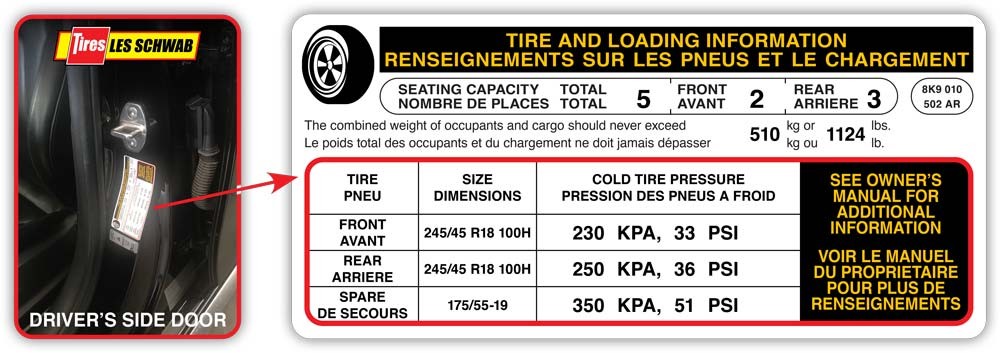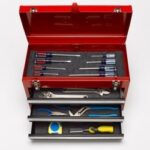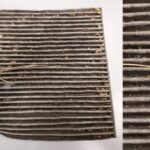Maintaining the correct air pressure in your car tires is crucial for both fuel efficiency and driving safety. The National Highway Traffic Safety Administration (NHTSA) highlights that under-inflated tires can significantly reduce your gas mileage and negatively impact your vehicle’s handling, braking performance, and collision avoidance systems. To ensure your tires are always properly inflated and to avoid these potential issues, consider a routine check. Les Schwab offers a complimentary monthly air check service. You can easily schedule an appointment online for tire services.
Understanding Your Vehicle’s Recommended Tire Pressure
It’s a common misconception that the PSI (Pounds Per Square Inch) number embossed on your tire sidewall indicates the ideal inflation pressure. In reality, this number represents the maximum pressure your tire can handle when cold. Your vehicle’s recommended tire pressure, which is often lower and more specific, is the figure you should always aim for.
To find the precise recommended tire pressure for your car, consult your owner’s manual. Alternatively, you can usually find a sticker on the driver’s side doorjamb that lists the recommended pressures for both front and rear tires when they are cold – typically measured first thing in the morning or before driving.
Step-by-Step Guide: How to Inflate Your Car Tires
Adding air to your tires is a straightforward process whether you are at a gas station or in your own garage. Most gas stations provide air compressors, usually located near the fuel pumps, which may require a small payment. For home inflation, you’ll need your own air compressor. In either scenario, a tire pressure gauge is essential for accuracy.
Here’s a step-by-step guide:
-
Begin by checking your current tire pressure. For an accurate reading, it’s best to do this when your tires are “cold,” meaning the vehicle hasn’t been driven recently or ideally in the morning. Use a tire pressure gauge for this. A typical gauge resembles a pen with a pressure indicator on one end and a valve connector on the other.
-
Position your vehicle safely. Ensure you park in a location where you can easily and safely access all four tires with the air hose, whether you are at a gas station or at home.
-
Remove the tire valve cap. Unscrew the small cap on the tire valve stem and store it in your pocket or a safe place to prevent losing it.
-
Attach the air compressor fitting securely. Press the air compressor nozzle firmly onto the tire valve stem. You should hear air flowing into the tire. If you hear hissing or feel air escaping, readjust the connection to ensure a tight seal between the nozzle and valve stem.
-
Inflate in short bursts, checking pressure frequently. Air compressors vary in inflation speed, so add air incrementally and check your tire pressure gauge often. Inflate slightly, check the pressure, and repeat until you reach the recommended PSI. If you over-inflate, you can release air by briefly pressing the center pin inside the tire valve.
-
Replace the valve cap. Once you’ve achieved the correct pressure, screw the valve cap back on tightly. This cap is important as it helps maintain tire pressure over time and prevents dirt and debris from entering the valve.
Quick Tip from Les Schwab: In an emergency, if you lack access to an air compressor or gas station, a bicycle pump can be used. However, be prepared for a significant amount of pumping, and be aware that it may damage the bicycle pump.
The Importance of Monthly Tire Pressure Checks
On average, tires can naturally lose about one PSI of pressure each month. These seemingly small losses accumulate over time and can lead to under-inflation. Make it a habit to check your tire pressure at least once a month. For added convenience, remember that Les Schwab offers free tire checks and inflation at any of their locations.
Risks of Driving with Low Tire Pressure
While momentarily reducing tire pressure might offer increased traction in conditions like deep snow, consistently driving with low tire pressure is discouraged and can be dangerous. Under-inflation can cause significant and irreparable damage to your tires, potentially leading to tire failure.
In the event of a flat tire, it’s crucial to address it promptly. If you cannot immediately inflate the tire, changing to your spare tire is the safest course of action to get you to a service center like Les Schwab. Vehicles equipped with run-flat tires offer a temporary solution, allowing you to drive for a limited distance to reach a repair shop if you experience a flat or pressure loss.
Let Les Schwab Assist with Your Tire Inflation Needs
For peace of mind, remember that Les Schwab is always ready to help. Visit any Les Schwab location for a free tire air check and inflation service. Their expert technicians will ensure your tires are inflated to the correct pressure, as part of their commitment to your safety and vehicle maintenance. This is just one of the many complimentary services Les Schwab is pleased to provide for you and your family’s well-being.


